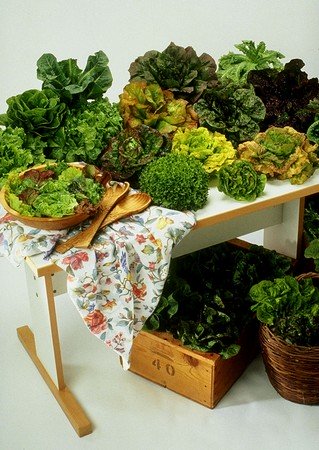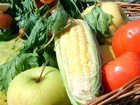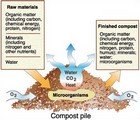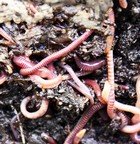10 Best Vegetable Gardening Tips for your Vegetable Gardens
If you have had a veggie patch but failed where most of the vegetables struggled to grow and the rest were buffet spreads for the insects and birds, we suggest that you don't give up but to try again, this time using our top 10 secrets to great vegetable growing.
Growing vegetables not only saves you money at the grocery store in feeding your family, but it also gives you a thrill of being able to be self-suffcient and know that you are growing good, clean food for your family's health.
Vegetable Gardening Tips #1 : Only Plant the Vegetables that you Like to Eat
Growing vegetables is time consuming, therefore it makes no sense to plant rows and rows of radishes just because they are a quick and easy vegetable to grow if no one eats them.Vegetable Gardening Tips #2 : Preparing the Soil for Growing Great Vegetables
Your soil is the life blood of your vegetables. If you have poor soil you will have poor vegetables. And there is really no excuse for poor soil. I have even grown vegetables most successfully on slabs of concrete when I didn't have a garden. Growing vegetables in containers is one way of controlling the soil composition.So how to you get good soil? You need to make sure that your soil has plenty of nutrients that will feed your vegetables as they grow. You do this by adding farmyard manure, blood and bone, and lime to your soil. However, not all plants like lime, so make sure that when you add the lime you are only adding it to areas that will complement the plants growing in that area.
 Farmyard
manures are the
backbone to improving poor soil, as well as
the addition of chopped pea straw or legumes that can be turned back
into the soil, such as a green cover
crop that was grown for this purpose.
Farmyard
manures are the
backbone to improving poor soil, as well as
the addition of chopped pea straw or legumes that can be turned back
into the soil, such as a green cover
crop that was grown for this purpose.Rabbit manure is excellent as you can add this directly to your plants without waiting for it to rot down, but any other manure, especially chicken manure which is rich in nitrogen but very strong needs at at least 6 weeks to rot down before adding it to your soil.
By adding manure to your soil you will also be cutting down on the amount of watering needed as your soil will now retain more moisture. The manure will also encourage good root development.
In addition to feeding your soil to build it up, you also need to know what the pH of your soil is and whether it is acidic or alkaline. Different fruits and vegetables prefer different pH levels and you need to know their preferences to prepare the soil accordingly. Cabbages, for example like a pH of 8.5 which is highly alkaline, whereas blueberries like acidic conditions with a pH of 4-6.
To make your soil more alkaline, add agricultural lime to your soil. Do this slowly and test after each application to make sure that you have the right conditions for whatever you are planting. Adding lime to your soil if you are planting brassicas is important for preventing clubfoot disease, a major problem of this family of vegetable. However, potatoes, pumpkin, and parsnips do not like lime at all.
Vegetable Gardening Tips on Liming the Soil
Peas, peppers, tomatoes, turnips, rutabaga and squash need a light application of lime every 3-4 years. 1 pound on a 22 foot row would be enough.Broccoli, corn, cucumber, eggplant, endive, kale, leeks, peas, melons, radishes and spinach like a moderate application of lime. About 3 pounds of lime to a 22 foot row every 3-4 years is sufficient.
Asparagus, beetroot, cabbage, cauliflower, carrots, celery, lettuce and onions are heavy lime feeders. Apply about 5 pounds to a 22 foot row every 3-4 years.
If you have a wood lot where you cut your own firewood for your open fireplaces the wood ash from hardwoods can be added to your soil as it will provide potassium necessary for raising the pH level of your soil if it is low and acidic. If you already have a good pH of say 7 and your soil is neutral or alkaline, then if you add more wood ash on a regular basis you will end up interfering with the plants ability to take up nutrients.
The Ideal pH Levels for Vegetables
Know what conditions your vegetables like growing in. Tomatoes, for example like an acidic soil with a pH of 6.0-6.5. However, almost all vegetables like a pH of 5.5 to 6.5.| Beans
6.0 to 6.5 |
Celery
6.0 to 6.5 |
Brassicas
6.0 to 6.8 Broccoli Brussels Sprouts Cabbage Cauliflower Kohlrabi |
Corn 5.8 to 6.8 |
Eggplant
5.5 to 6.0 |
Greens
6.0 to 6.5 Corn Lettuce Swiss Chard Spinach Upland Cress |
| Okra
5.5 to 6.0 |
Onions
5.5 to 6.5 |
Peas 5.8 to 7.0 |
Peppers
5.5 to 6.0 |
Potatoes
4.5 to 6.5 |
Root
Crops 6.0 to 6.8 Beets Carrots Kohlrabi Parsnips Radishes Rutabagas Turnips |
| Tomatoes
6.0 to 6.5 |
Cucurbita
6.0 to 6.8 Cucumbers Melons Pumpkins Squash |
Artichokes
6.5 - 7.5 |
Leeks 6.0 - 8.0 |
Garlic 5.5-7.5 |
Watercress 5.0 - 8.0 |
4 Elements needed for Good Soil:
Nitrogen is important for good growth, promoting cell formation and photosynthesis. Good sources for nitrogen are well-rotted manure, compost, fish-emulsion, blood meal, and legume cover crops.
Phosphorus promotes strong roots and the formation of flowers, fruits and seeds, and helps the plants resist disease. If the soil is poor in phosphorus your plants will stunted, with thin stems and a purple tinge to the leaves on the underside. Good sources for phosphorus can be found in bone meal and poultry manure.
Potassium is important for your plants to grow well and to resist disease. Too little potassium will result in stunted plants, poor yields and yellow leaves. A good source of potassium can be found in wood ash and greens.
Calcium is vital in building strong celled-walls and also prevents blossom-end rot which is a common problem in tomato growing. Natural sources of calcium include wood ash, crushed egg shells and bone meal.
These are the main elements, but of course, not all.Vegetable Gardening Tips #3 : Easy Vegetables to Grow
If you are growing vegetables for the first time, choose vegetables that are easy to grow:Beans, beets, broccoli, cabbage, carrots, chard, corn, endive, Jerusalem artichokes, kale, lettuce, okra, onions, parsnips, peas, potatoes, radishes, spinach, squash, tomatoes and turnips.
Vegetable Gardening Tips #4 : Selecting Fresh Vegetable Seeds
Make sure that you buy or use open-pollinated seeds that are organic. Any open-pollinated seeds can be planted and then harvested again and again, season after season. Seed-saving is one of the joys of growing your own vegetables.The seed that you use should be fresh and therefore important that you check the sell-by date on the packets. If you are keeping your vegetable seeds from one season to another then you should know how long your vegetable seeds will last.
| SEED | YEARS | SEED | YEARS |
| Asparagus | 3 | Muskmelons | 5 |
| Bean | 3 | Onions | 1 |
| Beets | 4 | Peas | 3 |
| Broccoli | 5 | Peppers | 2 |
| Cabbage | 5 | Pumpkins | 4 |
| Carrots | 3 | Radishes | 5 |
| Cauliflower | 5 | Spinach | 5 |
| Corn | 2 | Squash | 4 |
| Cucumbers | 5 | Tomatoes | 4 |
| Lettuce | 5 | Watermelons | 4 |
Plan your garden well in advance, usually during the winter is a good idea, and then draw out your beds on paper placing where your vegetables will go. Make sure that you protect your plants with companion planting, never planting just one type of vegetable in the beds. This is just asking for trouble.
Vegetable Gardening Tips #5 : Planting your Seeds out at the right Time for Growing Vegetables
It is also important to plant by the moon to get the best results. I have proved this time again. I particularly like Maria Thun's way of doing things and plant my vegetables according to her online calendar.
For those of you with limited space, grow more vegetables in less space by growing them according to Mel Bartholemew's Squarefoot Gardening method.
Vegetable Gardening Tips #6 : Planting Successively
When growing vegetables many complain that they end up with too many lettuces or too many tomatoes all at once. This happens when you end up planting your seeds all at once, rather than staggering the planting time.By staggering the planting time say, every 2-3 weeks, you can then be sure of getting a continual supply of your vegetables throughout the growing season.
If you do end up with a glut of one particular vegetable one can either freeze the excess or look at home canning.
Vegetable Gardening Tips #7: Feed your Vegetables
Don't neglect your vegetables once they are established. You will need to feed them regularly to get the best results. Particularly heavy feeders like tomatoes and strawberries. You can do this by making up a good growing brew. One of my favorites is this recipe:1 part fish emulsion
2 parts kelp (dried, powdered seaweed)
10 parts dried farmyard manure
50 part water
Mix in a large container. Cover. Leave to stand for 2 days, stirring occasionally.
To use pour half a pint around each of your corn, tomato, squash, melon, peppers and eggplants and the other pint over the leaves. The best way to do this is to take a small tree branch and dip it into the brew and flick it over the leaves until it is finished. Apply twice during the growing season.
For acid loving plants, add 1 teaspoon of cider vinegar to the pint and feed this to your strawberries and blueberry plants.
Vegetable Gardening Tips #8 : Spray your Vegetables with Organic Sprays
When you grow your vegetables organically, that doesn't mean to say that you never need to spray. You do, as there are lots of things that can go wrong with your vegetables:1) Sucking Insects such as aphids, scale, thrips and leaf hoppers.
2) Chewing Insects such as caterpillars, slugs and beetles.
3) Ground Insects that migrate from one plant to another, usually at night, such as snails, grasshoppers, cutworms and sow bugs.
3) Fungus and Blights like mildew, rust and leaf spot.
We have a page of natural pesticides for most insecticide and fungicide problems.
Vegetable Gardening Tips #9 : Water your Vegetables
A good watering program is very important when growing vegetables. If you do not water them regularly the vegetables will start to show stress and will not grow properly as a result. Tomatoes are particularly sensitive to erratic watering.Rather water your vegetables in the morning, rather at night, so that you don't encourage mildew, particularly if you live in a humid area. A good soaking every 2 days is preferable to light waterings every day, unless you live in a very hot area, where you will need to water every day.
Vegetable Gardening Tips #10 : Harvest your Vegetables
The best part of growing vegetables is of course harvesting your vegetables. Start harvesting them young when they are tender and sweet. Small carrots are delicious, so are pea shoots and tender beans. The more you pick the more you will harvest! Enjoy!For more information see our page on growing organic vegetables
If you have Vegetable Gardening Tips of your own we would love to hear from you.
Just send us your vegetable gardening tips by typing in the form below. We will post the submission within a day or two.Leave a Comment
Do you have anything that you would like to add after reading this page? We would love to hear your thoughts. If you can add additional information to what has been written here you will be adding value to the website! No need to have any special skills - just type and submit. We will do the rest!
Other Comments
Click below to see comments from other visitors to this page...
Nematodes Not rated yet
I read in local paper that a gardener "cured' his garden soil of nematodes by spraying the soil with Neem Oil. Does this really work and is it safe for …
Seaweed Uses for the Garden, Livestock, Poultry Not rated yet
If you live near the sea (obviously) seaweed can be used to improve the soil condition.
It can also be used to make up a liquid feed.
Don't pick …
Don't miss out on our latest news and articles. Sign up for our free monthly e-zine!
Go to Unusual Vegetables
Go to Growing Vegetables in Containers
Go to Companion Planting for Vegetables
Go to Organic Vegetable Gardening
Go to No dig Gardening
Go to Straw Bale Gardening for Vegetables
Go to Second Harvest for Late Vegetables
Go to When to Plant Vegetables
Go to Juicing Vegetables
Go to Self Sufficient Living
Go to Countryfarm Lifestyles and Homesteading










New! Comments
Do you have something of value to add? Leave me a comment in the box below.